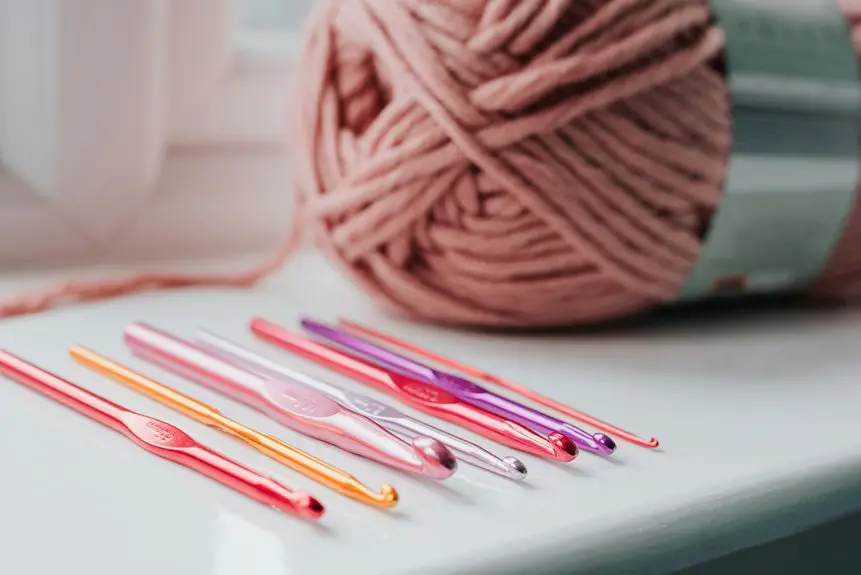Yes, you can paint on calico fabric, which is a durable, plain-woven cotton perfect for various projects. You’ll want to use fabric paints or acrylics with a fabric medium to keep your design flexible and vibrant. Prep your calico by washing and drying it to remove any sizing. After painting, set the paint with heat to guarantee it lasts. Keep going, and you’ll discover techniques, creative ideas, and care tips to bring your calico artwork to life.
Table of Contents
Key Takeaways
- Calico fabric is ideal for painting due to its tight weave, lightweight durability, and ability to hold paint without warping or bleeding.
- Use fabric paints or acrylics mixed with fabric medium for flexible, vibrant designs that withstand fabric movement.
- Prepare calico by washing to remove sizing, then stretch and secure it for a smooth painting surface.
- Fix paint by drying completely, then heat-set with an iron or heat press to ensure longevity and washability.
- Painted calico is perfect for creative projects like tote bags, cushions, scarves, and home décor items.
What Is Calico Fabric?
Calico fabric is a plain-woven textile made from unbleached cotton. When you touch it, you’ll notice its slightly coarse texture and natural off-white color.
It’s lightweight but durable, making it perfect for various craft and sewing projects. Because it’s unbleached, calico retains a natural, earthy look that many artists appreciate for its rustic charm.
You’ll find calico is affordable and widely available, which makes it a popular choice for beginners and professionals alike.
Its tight weave means it holds paint and dye well, allowing you to create detailed designs without the fabric warping or bleeding excessively.
Understanding these qualities helps you decide how to prepare and work with calico for your painting projects.
Types of Paint Suitable for Calico
When you choose paint for fabric projects, you’ll want options that adhere well to the natural fibers without cracking or fading.
Fabric paints are your best bet since they’re designed specifically for textiles and offer flexibility once dry. Acrylic paints mixed with a fabric medium also work well, giving you vibrant colors that stay soft on calico.
Fabric paints provide flexibility and vibrant color, especially when acrylics are combined with fabric medium for soft calico designs.
If you prefer natural options, dye-based paints penetrate the fibers, creating long-lasting designs. Avoid regular acrylics alone—they tend to crack when the fabric moves.
Additionally, fabric markers are great for detailed work or small areas. Whichever you pick, make certain it’s washable and suitable for cotton fabrics like calico to keep your artwork looking fresh and durable through wear and washing.
Preparing Calico Fabric for Painting
Before you start painting, make sure to wash and dry your calico to remove any sizing or dirt that could affect the paint.
You’ll also want to stretch and secure the fabric tightly to keep your work smooth and even.
Finally, consider pre-treating the fabric to help the paint absorb better and last longer.
Washing and Drying Tips
Although it might seem like a simple step, washing and drying your fabric properly can make a significant difference in how well your paint adheres and lasts.
Before you start painting, wash your calico fabric in cold water without detergent to remove any factory sizing or impurities. Avoid fabric softeners, as they leave residues that repel paint.
After washing, let the fabric air dry completely or tumble dry on low heat. High heat can shrink or distort the fibers, affecting your painting surface.
Make certain the fabric is fully dry before you begin painting to prevent bleeding or uneven absorption.
Taking these washing and drying precautions guarantees your calico fabric is clean, smooth, and ready to hold your artistic vision beautifully and durably.
Stretching and Securing Fabric
Once your calico fabric is clean and dry, you’ll want to stretch and secure it properly to create a stable painting surface. Stretching prevents wrinkles and uneven areas that can interfere with your brushstrokes. You can use a wooden frame or an embroidery hoop to keep the fabric taut. When securing, make sure the fabric is evenly tensioned without overstretching, which might distort the weave.
| Method | Tips |
|---|---|
| Wooden Frame | Staple fabric edges evenly |
| Embroidery Hoop | Tighten screw for firmness |
| Clip Boards | Use clips to hold edges |
Choosing the right method depends on your project size and paint type. Proper stretching guarantees smooth application and a professional finish.
Pre-treating for Paint Absorption
Since calico fabric is quite absorbent, you’ll want to pre-treat it to control how the paint soaks in and guarantee vibrant, lasting colors.
Start by washing the fabric to remove sizing and impurities that might repel paint. Once dry, apply a fabric medium mixed with your paint or a clear gesso to prime the surface. This layer creates a barrier that prevents paint from bleeding and saturating too deeply.
Let the primer dry completely before you begin painting. If you skip this step, your colors could appear dull or patchy.
Pre-treating also helps maintain the fabric’s flexibility, so your artwork won’t crack or peel over time. Taking these simple steps guarantees your painted calico looks sharp and lasts for years.
Techniques for Painting on Calico
When you start painting on calico, choosing the right technique can make all the difference in your final design. You might opt for brush painting to apply bold strokes and detailed patterns, using synthetic brushes for smoother lines.
Stippling works well if you want texture; lightly dabbing paint creates a soft, dotted effect. If you prefer a more controlled approach, try block printing with carved stamps to repeat motifs evenly.
Watercolor techniques also suit calico, but use less water to prevent fabric stretching. For vibrant, even coverage, screen printing is an excellent choice, especially for multiple pieces.
Remember to work on a flat, sturdy surface to avoid paint bleeding. Experimenting with these methods helps you find what best suits your project’s style and complexity.
How to Fix Paint on Calico for Longevity
Although painting on calico can produce beautiful results, you’ll need to fix the paint properly to guarantee your design lasts through washing and wear.
Start by letting the paint dry completely—usually 24 hours. Then, set the paint using heat: place a clean cloth over the painted area and iron it on medium heat for about 3-5 minutes, moving constantly to avoid scorching.
Alternatively, if your paint instructions allow, you can use a heat press. This step bonds the paint to the fabric fibers, enhancing durability.
After heat setting, wash the calico gently in cold water and air dry to preserve the design. By following these steps, you’ll maintain your artwork’s vibrancy and prevent fading or peeling over time.
Common Mistakes to Avoid When Painting Calico
If you want your calico painting to look its best, you’ll need to steer clear of some common pitfalls. Avoid using too much water, which can cause colors to bleed and fabric to wrinkle. Don’t skip pre-washing your calico; leftover sizing repels paint. Also, avoid painting on a loosely stretched fabric, as it can distort your design.
| Mistake | Why to Avoid It |
|---|---|
| Over-wetting fabric | Causes bleeding and wrinkling |
| Skipping pre-wash | Paint won’t adhere properly |
| Poor fabric tension | Leads to uneven, distorted painting |
Tools and Supplies Needed for Painting Calico
Steering clear of common mistakes sets a solid foundation for your calico painting, but having the right tools and supplies makes all the difference in bringing your design to life.
Before you start, gather these essentials to guarantee smooth application and lasting results.
- Fabric Paints: Choose paints specifically made for fabric to assure flexibility and washability on calico.
- Brushes and Sponges: Use various sizes and shapes to achieve detailed designs or broader coverage.
- Palette and Water Container: A palette helps mix colors precisely, while water is necessary for cleaning brushes between strokes.
With these in hand, you’ll be ready to express your creativity on calico fabric confidently and effectively.
Creative Project Ideas Using Painted Calico
When you’ve mastered the basics of painting on calico, exploring creative project ideas allows you to showcase your unique style.
Try designing custom tote bags by painting bold patterns or personalized messages. You can also create eye-catching cushion covers that add a handmade touch to your living space.
If you enjoy accessories, painted calico scarves or headbands make stylish, one-of-a-kind pieces. For home décor, consider crafting wall hangings or fabric banners featuring your artwork.
Smaller projects like bookmarks or fabric patches let you experiment with intricate designs without committing to large surfaces.
These ideas help you turn simple calico fabric into memorable, creative expressions that reflect your artistic flair. Don’t hesitate to combine techniques and colors to make every piece truly yours.
Cleaning and Caring for Painted Calico Items
To keep your painted calico looking fresh, you’ll want to wash it gently by hand and avoid harsh detergents.
When storing your items, make sure they’re completely dry and kept away from direct sunlight to prevent fading.
Taking these simple steps will help preserve your artwork for a long time.
Washing Painted Calico
Although painted calico offers vibrant and lasting designs, you’ll need to handle washing carefully to preserve its colors and texture.
To keep your painted calico looking fresh and bright, follow these essential washing tips:
- Hand wash gently: Use cold water and mild detergent, avoiding harsh chemicals that can fade paint.
- Avoid soaking: Don’t leave the fabric submerged for long periods; quick washing prevents paint from loosening.
- Air dry flat: Lay your calico flat to dry in a shaded area, preventing paint cracking or distortion from heat.
Storing Painted Items
Since painted calico requires careful handling to maintain its look, you’ll want to store your items properly to prevent damage.
Keep them in a cool, dry place away from direct sunlight to avoid fading. Fold your painted fabric gently, placing tissue paper between folds to prevent creasing or paint cracking.
Avoid stacking heavy objects on top, as pressure can distort the paint and fabric shape. If possible, store painted calico flat or rolled to preserve the artwork’s integrity.
When not in use, cover the item with a breathable cloth or cotton bag to reduce dust buildup.
Differences Between Painting on Calico and Other Fabrics
When you paint on calico fabric, you’ll notice it behaves differently than other materials like silk or linen.
Calico’s coarse weave absorbs paint more quickly, giving you less time to blend colors smoothly. Unlike silk’s smooth surface, calico offers more texture, which can add character but may challenge fine detail work.
Calico’s rough weave soaks paint fast, adding texture but making smooth blending and fine details trickier.
Also, calico is sturdier and less slippery, so it stays put while you work, unlike delicate fabrics that shift easily.
Here are three key differences to keep in mind:
- Absorption: Calico soaks up paint faster, requiring quicker brushwork.
- Texture: Its rough surface adds texture but limits fine detail.
- Stability: Calico holds steady, making it easier to paint without fabric movement.
Understanding these will help you adjust your technique effectively.
Where to Buy Quality Calico Fabric for Painting
If you want your painted calico to look its best, choosing high-quality fabric is crucial. You can find quality calico at local fabric stores, craft shops, or online retailers specializing in textiles. Look for tightly woven, pre-washed calico to guarantee smooth painting and durability. Here’s a quick guide to help you find the best sources:
| Source | Benefits |
|---|---|
| Local Fabric Stores | Feel fabric before buying |
| Craft Shops | Variety of fabric types |
| Online Retailers | Wide selection, convenient |
| Wholesale Suppliers | Bulk buying, cost-effective |
| Specialty Textile Shops | Premium quality, unique prints |
Frequently Asked Questions
Can Calico Fabric Be Dyed Instead of Painted?
You can definitely dye calico fabric instead of painting it. Because it’s natural cotton, it absorbs dye well, giving you vibrant, long-lasting colors. Just choose the right dye type and follow the instructions carefully for best results.
Is Calico Fabric Suitable for Sewing After Painting?
You want to sew, but you’ve just painted—can calico handle both? Absolutely! Once your paint’s dry and set, you can stitch away without worry, blending creativity and craft seamlessly in your projects.
How Does Humidity Affect Painting on Calico?
Humidity slows drying times and can cause paint to bleed or warp your calico fabric. You’ll want to work in a dry environment and guarantee your painted piece fully dries before handling or sewing to avoid smudges or distortion.
Can You Use Stencils on Calico Fabric?
You can definitely use stencils on calico fabric. Just secure the stencil firmly, use fabric paint or acrylic with a fabric medium, and apply paint carefully to avoid bleeding for crisp, clean designs every time.
Are There Eco-Friendly Paints for Calico Fabric?
You don’t need a magic wand to find eco-friendly paints for calico fabric. You’ll love water-based, non-toxic fabric paints made from natural pigments—they’re great for the planet and your artistic creations.
- Does Chiffon Fabric Stink - July 15, 2025
- Does Chiffon Fabric Affect the Economy - July 15, 2025
- Does Cotton Fabric Have a Nap - July 15, 2025







